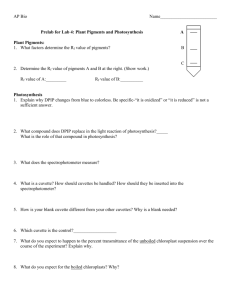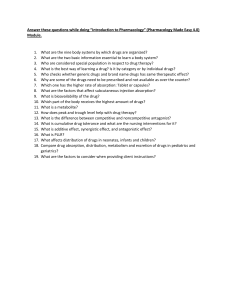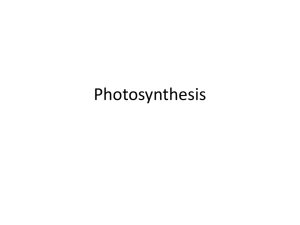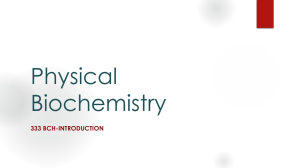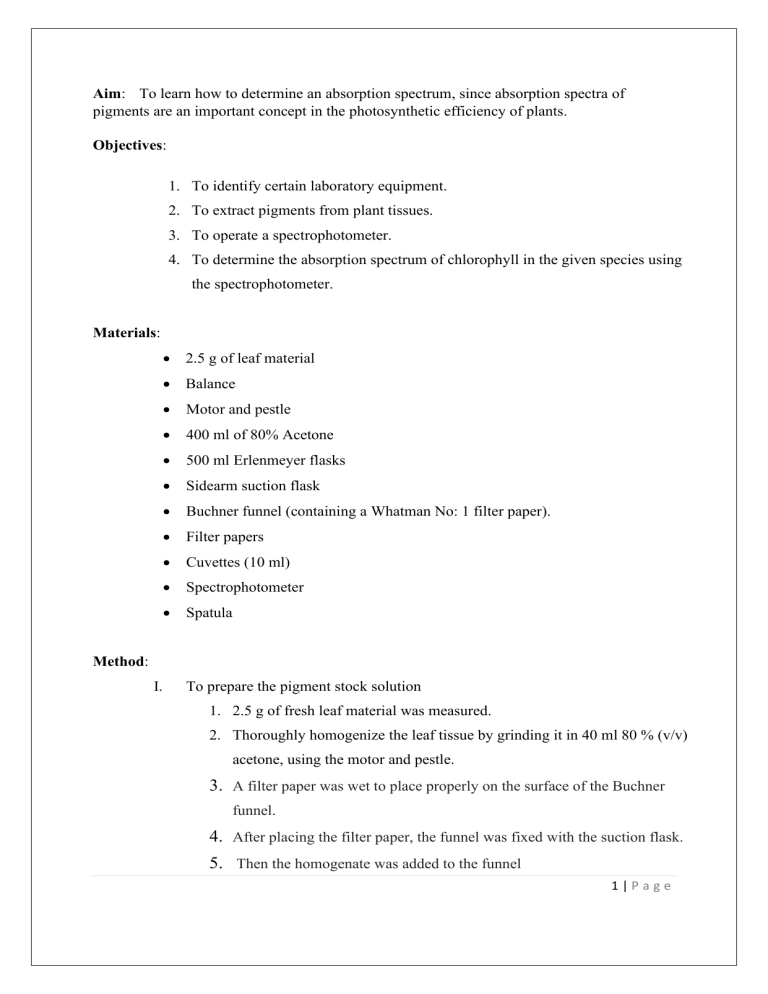
Aim: To learn how to determine an absorption spectrum, since absorption spectra of pigments are an important concept in the photosynthetic efficiency of plants. Objectives: 1. To identify certain laboratory equipment. 2. To extract pigments from plant tissues. 3. To operate a spectrophotometer. 4. To determine the absorption spectrum of chlorophyll in the given species using the spectrophotometer. Materials: • 2.5 g of leaf material • Balance • Motor and pestle • 400 ml of 80% Acetone • 500 ml Erlenmeyer flasks • Sidearm suction flask • Buchner funnel (containing a Whatman No: 1 filter paper). • Filter papers • Cuvettes (10 ml) • Spectrophotometer • Spatula Method: I. To prepare the pigment stock solution 1. 2.5 g of fresh leaf material was measured. 2. Thoroughly homogenize the leaf tissue by grinding it in 40 ml 80 % (v/v) acetone, using the motor and pestle. 3. A filter paper was wet to place properly on the surface of the Buchner funnel. 4. After placing the filter paper, the funnel was fixed with the suction flask. 5. Then the homogenate was added to the funnel 1|Page 6. After adding the homogenate into the Buchner funnel, tap was opened immediately to create the suction pressure 7. Then filter the homogenate into the flask. 8.The tissue debris was scraped back to the motor and pestle; repeat grinding and filtering once or twice to extract the pigments. (As much as possible). 9. After filtering well, this green filtrate was transferred into the measuring cylinder 10. All the green filtrates were transferred into the measuring cylinder, and it was mixed well. 11. Then the final volume was adjusted to 150 ml with 80% acetone. 12. All the green filtrates were combined, mix well and adjust the final volume to 200 ml with 80% acetone. II. To operate Spectrophotometer 1. Spectrophotometer was switched on half an hour before use to allow stability. 2. The wavelength control knob was adjusted to the 660 nm wavelength. 3. For the blank, 5 ml 80% acetone was used and adjusted the zero control knob until the needle reads zero absorbance. (Optical density). 4. Carefully 0.5 ml of pigment stock solution was poured into the cuvette. 5. Before placing the cuvette inside the compartment, both clear sides of the cuvette were wiped with a tissue. 6. The absorbance of the pigment solution was recorded at 660 nm. If it is greater than 0.4, diluted the solution with a known amount of 80% acetone until the absorbance is between 0.3 -0.4. 7. The absorbance (optical density readings) of the pigment solution was recorded at 10 nm intervals over a range of 350 to 700 nm (make sure to zero the instrument with the blank at each wavelength setting). 2|Page Results: Wavelength 350 360 370 380 390 400 410 420 430 440 450 460 470 480 490 500 510 520 530 540 550 560 570 580 590 600 610 620 630 640 650 660 670 680 690 700 Absorption 0.282 0.332 0.34 0.42 0.559 0.51 0.59 0.63 0.749 0.666 0.49 0.463 0.408 0.27 0.134 0.062 0.037 0.034 0.032 0.037 0.039 0.045 0.058 0.069 0.07 0.077 0.097 0.103 0.109 0.127 0.213 0.392 0.329 0.09 0.021 0.011 3|Page Absorption Spectrum 0.8 430, 0.749 0.7 Absorption 0.6 390, 0.559 0.5 0.4 660, 0.392 0.3 0.2 0.1 0 350 400 450 500 550 600 650 700 Wave length (nm) SPECTROPHOTOMETER 4|Page Discussion: In this practical, the main procedure is to determine the UV light absorption spectrum of the pigments. The spectrophotometer is the equipment that can be used to measure the absorption or transmission of light by any chemical solution. But this scenario mainly focuses on only the absorption process. The basic principle behind this scenario is the absorption of the light intensity based on the particular range of wavelength. This method is used for quantitative analysis purposes of various types of chemical solutions. In the initial phase of the practical, the homogenization happened to the leaves because to get accurate results from the practical there should be the same composition extraction as test samples. So need to get homogenized leaves by using mortar and pestle. Cuvettes are the small containers that are used to store the pigments’ extraction and when doing the experiment those should be kept inside of the cell content of the spectrophotometer. Cuvettes have four sides, among four sides two sides are clear and the other two sides are shaded. When placing cuvettes in the spectrophotometer shaded sides should be covered. The light beam is going through the clear sides of cuvettes. 5|Page There is a dial pad to adjust the measurements while conducting the practical. When changing the wavelength of the spectrophotometer from 10nm to 10nm there is an amount showing the absorption amount of photons that means the light intensity. When placed the cuvettes were in the cell container, the light intensity was absorbed after it passes through the sample extracted solution. If the absorptions mentioned as greater than 0.4 then the solution should be diluted with the 80% acetone until it comes to the 0.3 – 0.4 range because the spectrophotometer is not given the readings for highly concentrated solutions. In here to do the practical double beam spectrophotometer was used. In a visible spectrophotometer, the absorption of a particular sample can be determined by the wavelength. After considering the amount of absorption of the light under certain wavelengths roughly there are two wavelengths that absorbed more light intensity photons. Those are 430nm and 660nm. The visible range is 400nm – 700nm so the most absorption-showing wavelengths are within the visible range. The results showed that blue and red wave ranges absorbed more photons. So the pigments could be absorbed more light energy under the 430nm wavelength and 660nm wavelength. In this practical, there is an overall photon absorption spectrum that can be seen because in the initial phase there were no extracted pigments separately. Therefore, chlorophyll a, chlorophyll b, carotene, xanthophyll are pigments extracted in the sample solution. So as a result of that common spectrum of the pigments can be seen. Plant pigments are not soluble in the water perfectly. Acetone is a nonpolar organic compound (nonpolar methyl group) so it interacts with some polar substances and also it has a polar carbonyl group because this acetone perfectly interacts with water too. The lipid bonds that are occurred in the chlorophylls can be broken down into a thylakoids structure and suspend the pigments in the solution. Acetone can be concerned as a standard chlorophyll extraction solvent. 6|Page The reason is not using water for the chlorophyll extraction because most of the pigments inside the chlorophyll are not soluble in water. So to get more solubility chlorophyll extraction is done by using acetone. The other reason is 80% - 100% concentrated acetone solution is crated a typical medium for the extraction process by being less toxic than other chemicals and also acetone is conducted its stability over 10 to 48 hours because of that there may not be happened any changes due to the changes of acetone while conducting the experiment. The blank test allows setting the spectrophotometer to zero before we take the reading for an actual solution. Blank test means the measuring of absorption of the other solvents except for the sample which needs to measure the absorption in order to get the absorption spectrum. In simply the solution which is used to do the blank test has all other unknown solvents without the solution that need to measure the absorption. If the scale adjusts to zero value by using the acetone sample then the other measurements which wish to take after the blank test have the relative measurement as a result of that there is a way to get accurate absorption of the light intensity only through the pigments. The measurement of the blank test is carried out under the same experimental conditions such as the same instruments and same environmental condition due to that, through the blank test the absorption of other things except chlorophyll pigments may mitigate. Conclusion: • The high absorption range of wavelength of light intensity from the pigments can be identified by using a spectrophotometer. • Only chlorophyll a and chlorophyll b are responsible for photosynthesis. • Blank test is acted as a reference to the whole experiment. 7|Page • After getting readings for the range of 350nm – 700nm, could be concluded as the high absorption happened during the 439nm wavelength and 660nm wavelength. In the graph, it can be seen clearly on the two peaks of the graph. • As well as within the range 350nm – 660nm there are vary absorption energies can be seen. Reference: • Hussain, A 2019, UV-Visible Spectrometry, Research Gate, Kerbala https://www.researchgate.net/publication/337674152_UVVISIBLE_SPECTROMETRY 8|Page
